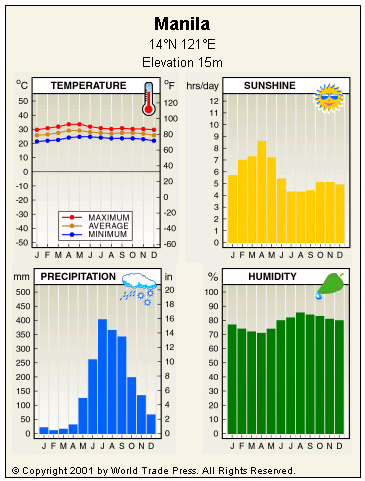Country Snapshot: Climate Overview
The Philippines is located in Southeast Asia, in the western Pacific Ocean. It is an archipelago of more than 7,100 islands. Its west coast, which lies along the South China Sea, has a tropical monsoonal climate with pronounced wet seasons and short dry seasons, driven by the seasonal monsoons. Its east coast, which faces the Philippine Sea, is a tropical rainforest with no dry season. All of the larger islands are mountainous, and some ranges and peaks climb as high as 3,000 meters (10,000 feet).
Seasons
The cool dry season, called tag-lamig, occurs from November to February. During this time the sun may be visible for 7‒8 hours per day on average.
The hot dry season, called tag-araw, runs from March to May.
The wet season, called tag-ulan, extends from June to October. Rainfall is often particularly heavy due to typhoons from the South China Sea. These may be characterized by high winds and torrential rain, and can cause flooding, landslides, and wind damage.
Regional Variations
The Philippines can be divided into three major climatic zones: the western islands (and western coasts of major islands), the eastern islands (and eastern coasts of major islands), and the central islands (and large-island interiors). Temperatures can range from 23‒33°C (73‒91°F) in the interior and eastern areas, while the western region is warmer.
The western islands and coasts have a tropical monsoon climate, with distinct wet and dry seasons. Temperatures can range from 21‒35°C (70‒95°F), with the hottest temperatures in April and May. Monthly rainfall ranges from 17‒426 millimeters (0.7‒17 inches).
The eastern islands and coasts have more consistent rainfall throughout the year. Northeastern coastlines are exposed to Pacific trade winds between November and March, so that rainfall is heaviest during these months. Rainfall can vary from 65‒238 mm (2.6‒9.4 in).
The country’s interior has more consistent rainfall across the seasons, with some areas having no true dry season. Monthly rainfall can vary between 53‒309 mm (2.1‒12 in).
Copyright © 1993—2025 World Trade Press. All rights reserved.

 Philippines
Philippines 
